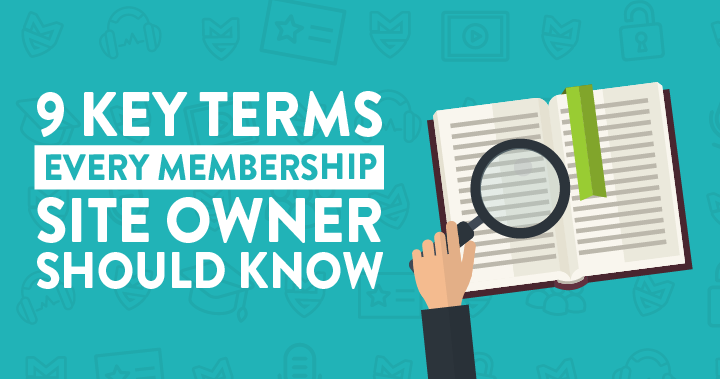Every industry, topic and niche has its fair share of jargon.
And memberships are no different.
There’s already so much to juggle as a membership site owner, so the last thing you want to have to worry about is needing to wrap your head around all of the lingo!
So to make it easier for you, we’ve rounded up the 9 key terms and phrases you need to know if you run a membership.
Retention
Retention relates to hanging onto your paying members.
Keeping them subscribed and paying month after month, year after year.
When it comes to membership, retention is arguably more important than initial sales.
The key to recurring revenue is that it actually recurs; so you need a strategy to ensure your members stick around long term in order to ensure a healthy membership.
Churn
When a member ends their subscription – either through cancellation, too many failed payments or opting not to renew, they’re deemed to have “churned”.
The total number of churned members over a given period of time – when calculated as a percentage of how many members you started that period with – gives you your “churn rate”.
So if, for example, you start August with 100 members, and 10 of those members leave during the month, then your churn rate is 10%.
You want your churn rate to be below 10% at most – if you can get it to 5% and below then that’s the holy grail.
Most importantly, however, is that you’re bringing in more new members than you lose so as to avoid negative growth.
Onboarding
Member retention starts day one, minute one.
The second someone joins your membership site, the clock is ticking.
So it’s important to ensure that you are onboarding new members effectively to improve the chance of them staying subscribed.
This can include things like providing a tour of your member area, giving them a checklist of initial tasks to complete or perhaps even an ‘induction’ course.
Engagement
If members aren’t actually using what they’re paying for them they won’t keep paying for it for long.
You want members to be regularly:
- logging in
- viewing content
- completing courses
- downloading your resources
- posting in your community
Or whatever else it is that indicates they’re actually participating and consuming your membership deliverables.
Dunning
While members deciding to cancel their subscription is an inevitable part of running a membership; you’ll actually find that much of your churn comes from failed payments.
And it’s not always due to them simply not having the funds.

This is probably a last resort
Sometimes members’ credit cards will have expired or they’ll have switched banks; and often banks will reject payments for completely unknown reasons.
Fortunately there are “dunning” services available such as Churn Buster and Gravy which will automatically try to pre-empt problems as well as attempt to chase and resolve failed payments.
Lifetime value
Essentially this boils down to figuring out how much each member signup is actually worth, financially, on average.
This means knowing 2 key pieces of information:
- What’s the average number of payment cycles someone sticks around for?
- What’s the average financial value of each payment cycle
If a typical member stays for 6 months; and your monthly payment is $50 – then the average customer lifetime value for each new member who joins is $300.
This information is critical for deciding on things like advertising budgets and other expenses as well as maintaining a healthy ‘Customer Acquisition Cost’ (CAC)
Gamification
A popular means of encouraging members to engage with your site and your content is using gamification strategies in your membership.

Often this is fairly basic – tracking member progress in courses, perhaps awarding badges for certain accomplishments; however some sites take it a lot further – for example NerdFitness.com which models it’s health and fitness membership around MMORG’s like World of Warcraft.
Risk reversal
When someone is deciding whether to join your membership, they will typically be filled with questions, doubts and concerns over their buying decision.
Will they get their money’s worth? Is this a scam? Can you deliver what you promised?
The list goes on.
Risk reversal techniques aim to shift the ‘risk’ of a transaction away from the buyer onto you as a seller.
For memberships this usually means offering things like trial periods and money back guarantees – where you undertake an element of manageable/acceptable risk in order to make it easier for someone to sign up with greater confidence and comfort.
Social Proof
People have a tendency to “follow the crowd” and make buying decisions influenced by the recommendations and reviews of their friends or even just impartial people they associate themselves with.

We use testimonials like this to promote Membership Academy
Seeing one or more of your members advocating for your product can play a much bigger part in convincing someone to join that any sales copy you write yourself.
Testimonials, case studies, reviews and the like can be extremely powerful marketing tools for your membership.
So there you have it – the 9 key terms every membership site owner needs to know.
Did we miss any? Let us know in our free Facebook group!
Thank You For Listening
We really appreciate you chosing to listen to us and for supporting the podcast. If you enjoyed today's show, please share it using the social media buttons on this page.
We would also be eternally grateful if you would consider taking a minute or two to leave an honest review and rating for the show in iTunes. They're extremely helpful when it comes to reaching our audience and we read each and every one personally!
Finally, don't forget to subscribe to the podcast in iTunes to make sure that you never miss an episode





